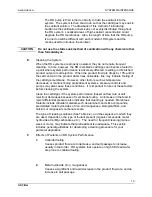
SYSTEM MAINTENANCE
MANOWNROSM
US Filter
18
f.
The RO is run in the normal operating mode with the product
diverted to drain until all residual sanitization chemical is flushed
from the system.
2.
Recirculation Method
This method requires an accessory tank and booster pump. A sanitant
solution is prepared in the tank and fed to the RO system via the booster
pump. The product and reject streams are diverted to the tank and the
sanitant is recirculated through the system for a period of time.
The advantages of the recirculation method of sanitization are minimal
usage of chemical, and ease in obtaining the proper sanitant
concentration. In addition, the accessory tank and booster pump may
also be used for system cleaning.
The following steps provide a general guideline for the recirculation
method of sanitization.
a.
A batch of sanitant, typically 40 to 100 gallons (160 to 400 liters),
is prepared in the tank by diluting sanitization chemical with water.
b.
The product and reject lines are diverted to the tank.
c.
The feed to the RO is connected to the outlet of a booster pump,
which pumps sanitant out of the tank.
d.
The booster pump is turned on and the RO is run in the normal
operating mode for 30 to 60 minutes.
CAUTION
Monitor the solution temperature during recirculation. Do not allow the
temperature to exceed 25
°°°°
C.
e.
The booster pump and the RO system are shut down and the
sanitant is allowed to sit in the system (optional).
f.
The RO is switched back to the normal feed source and run in the
normal operating mode with the product diverted to drain until all
residual sanitization chemical is flushed from the system.
g.
The tank and booster pump are drained and flushed with clean
water.
3.
Static Soak Method
This sanitization method may be used in combination with either
recirculation or continuous injection sanitization for heavily bio-fouled
systems. In this method, sanitant is introduced into the system and then
the system is shut down. The membranes are allowed to soak in the
sanitant solution for a period of time ranging from as little as 30 minutes
up to several days (check with your US Filter representative for
recommended maximum soak time).
Occasionally a system must be sanitized without a chemical feed system
or an accessory tank and booster pump. In this case it is possible to
perform a static soak sanitization by placing concentrated sanitant in the
RO system prefilter housing, or by manually injecting it into the feed line.
















































